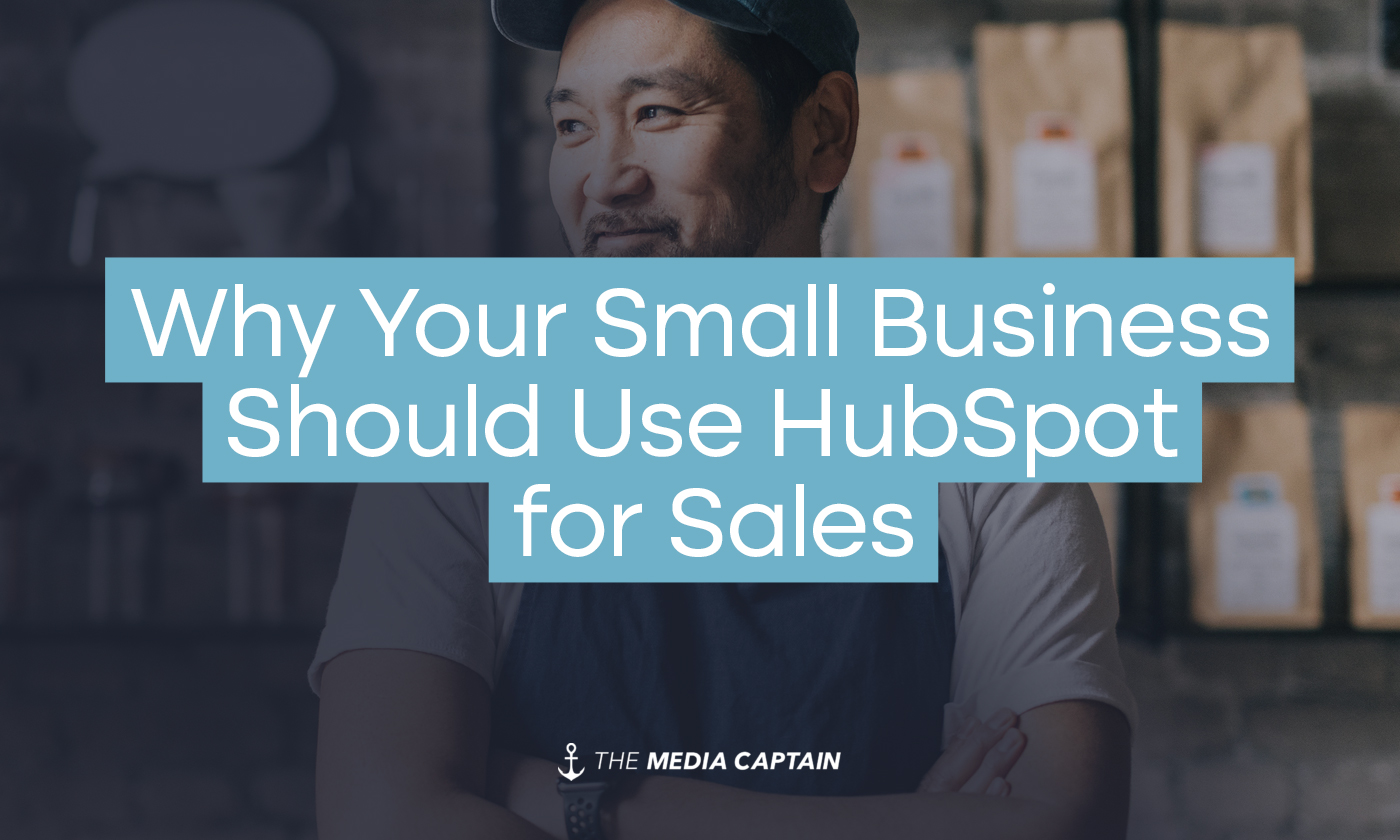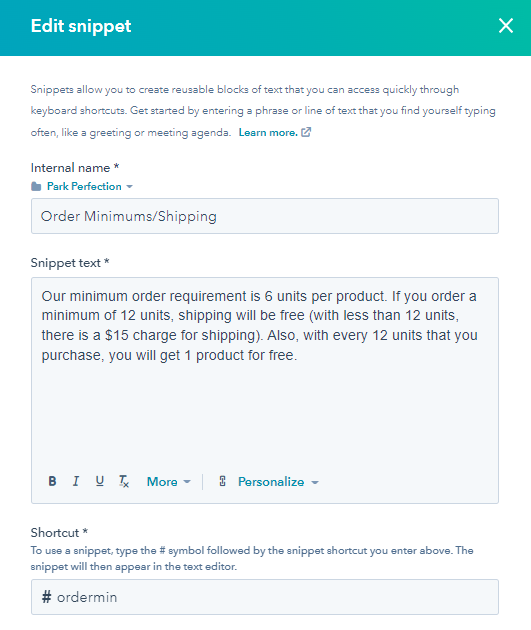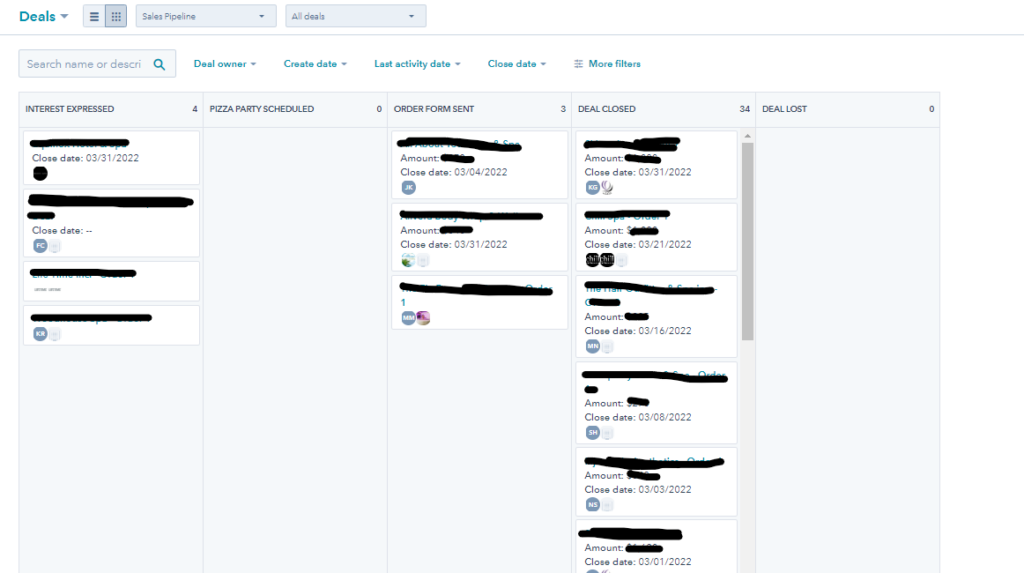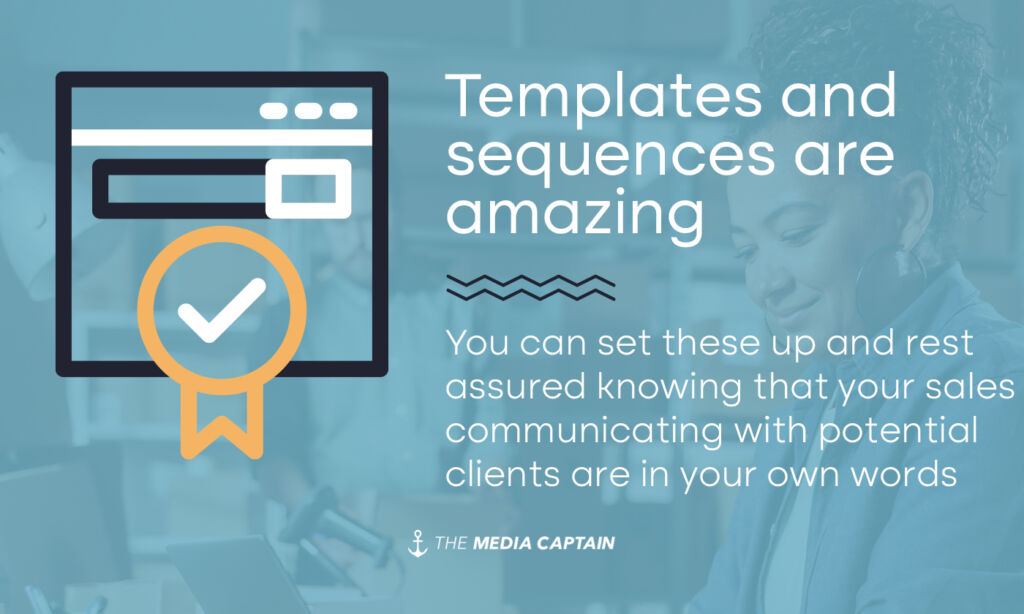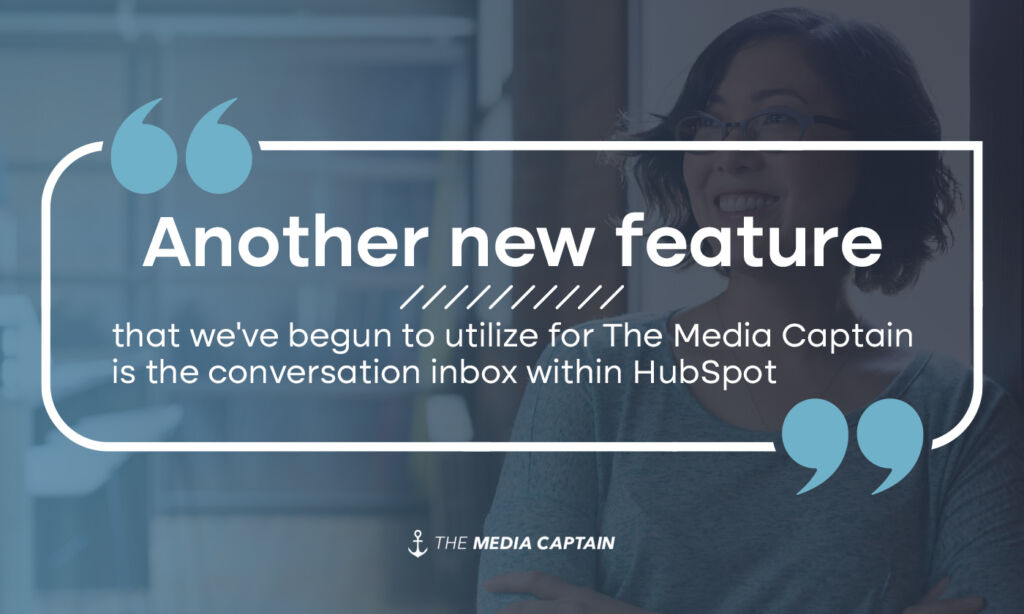If your business is generating more than a few leads per month, you should highly consider a CRM for your sales process. A CRM (customer relationship management) is a technology that will help you manage relationships and communications with your customers and potential customers. When it comes to organization and follow up, utilizing a CRM platform is a game changer.
For The Media Captain, and our in-house beauty brand, Park Perfection, we started using HubSpot for sales and we’ve never looked back. Utilizing this CRM software has taken our sales process to the next level, helped us scale, stay organized, and automate so many parts of our process, improving efficiency beyond belief. Don’t just take my word for it though.
CRM increases sales (by up to 29%), improves productivity (by up to 34%) and boosts forecast accuracy (by 40%) [source]. If you’re a small business, you may be thinking that you’re not large enough to use a CRM, but you’re wrong. 91% of companies with more than 11 employees use a CRM system and 50% of companies employing fewer than 10 people do as well [source].
Regardless of your size, the monthly cost of a CRM can be well worth it based on the additional leads it can help you bring in. As we were building our sales process for The Media Captain and Park Perfection, we started out by using our project management software, Monday.com, to track leads and follow ups. Monday proved to be a great resource for this, until we scaled. At that point, we needed help staying organized, creating follow-up tasks and flows. This is why we moved to HubSpot. We leverage this platform for outbound and inbound sales for each brand. Let me tell you some of my favorite things about HubSpot and why your business should consider it.
Before diving in, I do want to note that for both The Media Captain and Park Perfection, we’re using the Sales Hub Professional package from HubSpot. We recently upgraded from the Sales Starter so that we could take advantage of Workflows, Quotes and the Product Library. Best decision ever!
Want to learn more about getting started with HubSpot how you can grow your business using a CRM? Contact The Media Captain!
Table of Contents
- 1 Why Your Business Should Use HubSpot for Sales:
- 1.1 Sequences for outreach and follow up
- 1.2 Templates & snippets make communication easier than ever
- 1.3 Ability to link to email & track all communication
- 1.4 Tasks help you stay organized with your day-to-day
- 1.5 Deals & quotes give help you bring your sales to the finish line
- 1.6 Ability to take payment through Hubspot and link invoices directly to Quickbooks
- 1.7 Product Library
- 1.8 Customizations to meet your every need
- 1.9 Amazing customer support to help you through the process
- 1.10 Utilizing workflows to automate steps in your process
- 1.11 Conversation Inbox helps organize team emails
- 1.12 HubSpot Forms
- 2 In Closing
Why Your Business Should Use HubSpot for Sales:
Sequences for outreach and follow up
According to HubSpot, with the sequences tool, you can send a series of targeted, timed email templates to nurture contacts over time. You can also automatically create tasks to remind you to follow up with your contacts. When contacts reply to the email or book a meeting, they will automatically unenroll from the sequence.
Sequences have been an absolute game changer for both Park Perfection and The Media Captain. We’ve been able to set up templated emails that are automatically sent to leads at specific times. When it comes to outreach, follow up is extremely important. HubSpot’s sequences take all of the follow up tasks off of our plates.
Learn More: How to Use HubSpot Sequences for the Best Follow-Up
The sequence below is one that we use for Park Perfection. We’re reaching out to different spas throughout the country to try to get them to sell our skin care products. First, we call each spa to confirm the business owner and address. Once we have confirmation, we send a package of samples out. After 10 days (once we know they have received the samples), we start following up to make sure they received the package and get their opinion on the products. As you can see, As you can see in the image below, we incrorporate tasks like phone calls with sending automated emails at certain dates within the process.
We use HubSpot for The Media Captain for a similar sales process where we’re reaching out to businesses. We also use sequences for The Media Captain to send out follow up emails to potential clients we’ve sent quotes to that haven’t gotten back to us, plus many more.
Whether we’re sending an email follow up or setting a task to make a phone call or send a text message (which can be done by integrating something like SalesMsg with HubSpot), sequences make our entire follow up process a breeze. We’re also able to track opens and clicks, which gives us analytics into which emails are performing best and which parts of the messages people are most interested in.
Before moving over to HubSpot, we used Monday.com for all of our follow-ups. We had our lists of contacts within Monday and would set dates for follow ups. While this certainly did work, it was extremely time consuming and if something came up or we missed a day of follow-ups, we were behind schedule. Not to mention the times that we undoubtedly just forgot to follow up with someone. HubSpot’s sequences have made a huge difference in our follow up process.
Templates & snippets make communication easier than ever
When it comes to sales outreach and follow-ups, a lot of the communication tends to be similar regardless of who you’re reaching out to. Sure, there is always some customization that’s required, but the gist of the messaging can be the same. HubSpot allows you to create email templates and snippets making communication so fast and easy.
According to HubSpot, the key difference between templates and snippets is the word count. When using snippets, keep your word count to 500 characters or less. Think of snippets as little bits of information that you include within emails. We use snippets for any short tidbits that we frequently add to our emails. For example, billing options, instructions on how to use a product, or pricing for a product or service. Below is an example of a snippet for Park Perfection about our order minimums and shipping costs. We can easily pop this into any email we’re writing to let our contacts know about our requirements.
We’ll use templates for all of our follow up emails within our sequences for both The Media Captain and Park Perfection. You can personalize these with first name, company name, etc. and then customize each email as necessary, depending on who were writing to and where they’re at in the process.
For both The Media Captain and Park Perfection, most of our templates have sections that we customize. We want to personalize each email we’re sending to include information pertaining to a particular company and specifics about the conversation we had. The template, however, gives us a great starting point and ensures that we don’t have to write each and every email from scratch.
As a business owner, templates and sequences are not only a huge time saver, they also allow us to create all of the communication up front that our sales team will be having with potential clients. We can rest easy knowing that the sales team is communicating with potential clients with emails that we created ourselves. It takes a lot of the guesswork out of the equation and gives you one less thing to worry about and think about.
Ability to link to email & track all communication
Using the HubSpot Google Chrome Extension, you can login directly from Chrome so that any emails that you’re sending from your email account are tracked into HubSpot. This allows you to see who is opening and clicking your emails and when may be a good time to respond.
Not only that, you can create tasks for yourself and utilize sequences and templates directly from your inbox. You can also track all of the links you’re sending to see who is clicking on what. As if that weren’t enough, all of this activity will be tied back to the customer within HubSpot, so when you login you can see your entire history right there.
It’s really nice being able to go about your day and send emails as you normally would without having to worry about actually being logged into HubSpot to track these. Everything is done right from your own email! If you don’t use Google Chrome, don’t worry. You can also download extensions for Gmail, Office 365, and Outlook desktop.
Tasks help you stay organized with your day-to-day
Within any contact or company, you can assign a task to follow up via phone, send an email, or even shoot them a text message. There’s a task section within HubSpot where you can see all of your outstanding tasks for the day or for the upcoming week and easily go through to check them off your list. When your sales team is constantly reaching out to prospects, there are tons of touchpoints that need to be noted based on each conversation you have. HubSpot tasks helps with organization and ensuring everything on your to-do list actually gets completed. You can get task notifications directly within HubSpot or sent to your email to remind you.
Learn More: Text Message & SMS Marketing Tips
Not only can you stay on top of your own tasks, you can also look into tasks of your team members to ensure they’re not letting anything fall through the cracks.
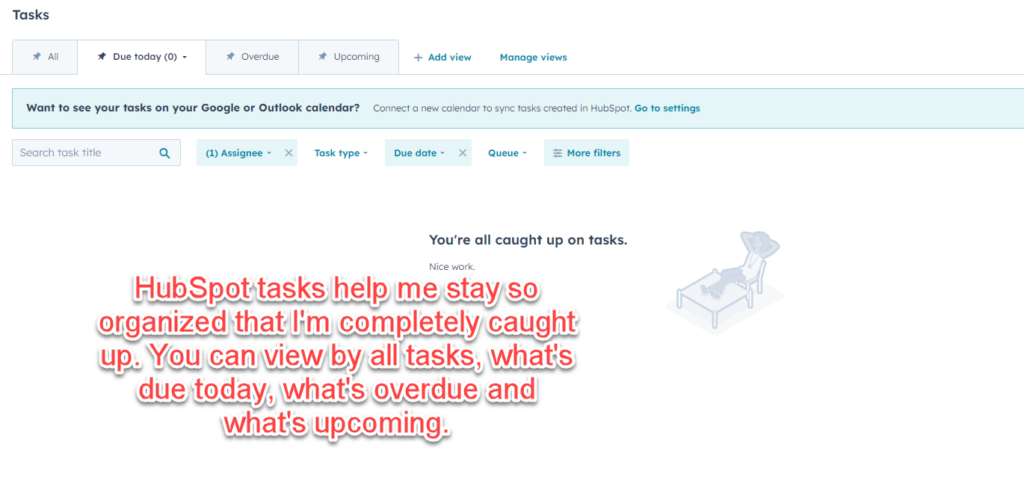 Deals & quotes give help you bring your sales to the finish line
Deals & quotes give help you bring your sales to the finish line
Before using HubSpot, when a sales rep was ready to send a quote and close a deal, they would have to get with me or Jason (the business owners) to send over a quote or an invoice from QuickBooks. This meant that they weren’t able to get through the whole sales process themselves and it added a lot of work to our plates. Not only that, anytime we had a hot lead, we’d need to keep track of this in Monday.com. Again, it worked at the time, but it made it more difficult to keep track of our leads and remember to follow up.
With HubSpot deals, we’re able to track potential revenue. We create a deal whenever one of our contacts takes an action that could lead to revenue for us. Whether this is sending them a quote or booking a meeting, we can now keep track of every stage in the deal closing process. We’re able to easily see which clients are at which step, also making follow up a breeze. I know there’s a lot of information blacked out in the image below, however, hopefully this gives you an idea of what the deals dashboard can look like:
You can also create quotes directly within HubSpot to share with your contacts who are interested in buying a product or service. Within the quotes you can include pricing information and even take payments (see more information about this below). Again, this makes it so easy for the sales team to be responsible for every step in the sales process and gives them a perfect snapshot of where they’re at with each of their contacts.
Ability to take payment through Hubspot and link invoices directly to Quickbooks
This is something we recently set up for both Park Perfection and The Media Captain and we’re extremely happy with this functionality. Our process used to be that we’d get a signed quote and then we’d need to create an invoice within QuickBooks to send to the client to finalize the deal. This was an extra step added to the process and something the members of our sales team weren’t able to complete on their own.
We were able to link our QuickBooks accounts directly to HubSpot and set up payment through HubSpot as well. Now when we send a quote over to a contact, they can sign the quote and pay for the products and services all in one easy step. Once the payments have been made, we can create an invoice from the Quote directly within HubSpot and it syncs up with our QuickBooks account. Then if we make any changes to the invoice within either QB or HubSpot, the change is reflected everywhere. It’s magical! Now not only is the whole process extremely organized, our sales team is able to manage this from start to finish.
Product Library
Once we started utilizing HubSpot for all of our quotes, we were able to build out a product library, which once again, made our entire process less cumbersome and more automated. Within HubSpot, you can create an entire library of everything you sell. This means that creating quotes is a breeze because you don’t have to manually input each and every product. Once the templates are set up in your product library you can pull them easily into your quotes.
Customizations to meet your every need
There are so many ways you can customize HubSpot to meet your needs. We have done a lot of work to customize the Companies and Contacts screens, for starters, so we can see accounts we’ve closed vs. open accounts, vs. accounts that need nurturing. We’ve been able to use filters through HubSpot to pull in different companies based on where they’re at in our process, which makes it so easy to follow up with different contacts at different stages.
Another helpful HubSpot customization is within our main dashboard, which allows us to see reporting on our sales process. You can choose from tons of different graphs and charts to show everything from deals & closed revenue to call outcomes per rep to all of your sequence data. This is extremely helpful to monitor sales reps and get a general overview of everything happening within the sales process.
In addition to the customizations mentioned above, there’s also a lot of opportunity to customize properties within contacts, companies, deals and more. These allow you to keep track of different aspects of each area in an easy to see area. It’s so much fun figuring out the best views for your reps and what makes the most sense.
Amazing customer support to help you through the process
HubSpot has excellent chat support. We’ve utilized their live chat many times to ask about best practices or how to execute on an idea that we have in mind. We have always gotten a very friendly rep who has been able to guide us through even the most obscure situations. They are extremely patient and will walk you through step by step whatever needs to be done to resolve your issue. Whether you’re having an actual problem or are just trying to figure out the best way to make something work for your business, the support has been phenomenal and so helpful. HubSpot also has fantastic support articles on almost any topic you can think of, so you can get written instructions whenever you need them.
Utilizing workflows to automate steps in your process
Like sequences, workflows help automate your sales process. Sequences send emails from your connected inbox as sales emails. On the other hand, workflows use marketing emails that are saved for automation. These emails are sent through HubSpot and the from address can be customized in the email editor.
According to HubSpot, workflows works in concert with HubSpot’s list segmentation tool, making it easy for you to build hyper-specific segments of leads whom you can target with customized marketing campaigns. Want to send an automated welcome email to all new customers? Omit leads with a “Gmail” address from your marketing campaigns? Nurture new whitepaper leads in different ways depending on their industry and company role? These things (and an infinite number of other uses) are all possible with Workflows.
When it comes to automating other parts in your sales process, there’s so much that you can do with automations. For example, there is some overlap that occurs between contacts and companies within our account. We used to manually enter information into a contact once the respective company was created, such as phone number, address, and company name. Instead, we were able to set up a workflow to handle this. This seems like something so small, but it has saved us a ton of time.
Conversation Inbox helps organize team emails
The conversation inbox within HubSpot gives you one central location where messages will show. This is super helpful if you have multiple people managing a group of messages. For example, for The Media Captain, we set up an inbox for our development team. Prior to setting this up, we had an email account that had forwarding set up to all of the developers on our team. It was really hard to keep track of who was responding to what and seeing full conversations was almost impossible.
Now with the HubSpot inbox, all of our development requests and emails go to one centralized location. Anyone from the development team can login to HubSpot to respond to messages, create tickets and keep track of entire conversations. Not only that, you can write notes for other team members and tag them if they need to step in. When it comes to organization and being able to stay on top of conversations, the HubSpot Inbox has been a huge help.
HubSpot Forms
We switched out the contact form on our website with a HubSpot contact form. We were able to completely customize this form, and the amazing functionality with this is that you can associate different fields in the form with different properties within HubSpot. Now, whenever someone fills out a contact form on our site, a contact is automatically created for them within HubSpot. This allows us to keep track of all of their information, plus their responses to our contact form, directly within their HubSpot contact. Before making this switch, each time a qualified lead came in, we would manually add them as a contact within HubSpot. This contact form saves us so much time!
In Closing
- If your business is generating more than a few leads per month, you should highly consider a CRM.
- HubSpot has been a game-changer for our businesses in terms of organization, automation, and staying on top of all of our leads.
- There are so many capabilities within HubSpot to help your business grow and help your sales team succeed.
- If you start using HubSpot and spend the time getting your account set up, you will never look back.


